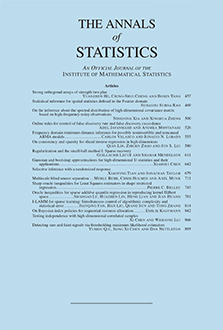Abstract
Consider the multiple testing problem of testing null hypotheses H1,…, Hs. A classical approach to dealing with the multiplicity problem is to restrict attention to procedures that control the familywise error rate (FWER), the probability of even one false rejection. But if s is large, control of the FWER is so stringent that the ability of a procedure that controls the FWER to detect false null hypotheses is limited. It is therefore desirable to consider other measures of error control. This article considers two generalizations of the FWER. The first is the k-FWER, in which one is willing to tolerate k or more false rejections for some fixed k≥1. The second is based on the false discovery proportion (FDP), defined to be the number of false rejections divided by the total number of rejections (and defined to be 0 if there are no rejections). Benjamini and Hochberg [J. Roy. Statist. Soc. Ser. B 57 (1995) 289–300] proposed control of the false discovery rate (FDR), by which they meant that, for fixed α, E(FDP)≤α. Here, we consider control of the FDP in the sense that, for fixed γ and α, P{FDP>γ}≤α. Beginning with any nondecreasing sequence of constants and p-values for the individual tests, we derive stepup procedures that control each of these two measures of error control without imposing any assumptions on the dependence structure of the p-values. We use our results to point out a few interesting connections with some closely related stepdown procedures. We then compare and contrast two FDP-controlling procedures obtained using our results with the stepup procedure for control of the FDR of Benjamini and Yekutieli [Ann. Statist. 29 (2001) 1165–1188].
Citation
Joseph P. Romano. Azeem M. Shaikh. "Stepup procedures for control of generalizations of the familywise error rate." Ann. Statist. 34 (4) 1850 - 1873, August 2006. https://doi.org/10.1214/009053606000000461
Information





